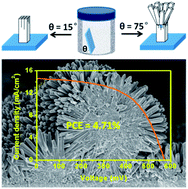Substrate placement angle-dependent growth of dandelion-like TiO2 nanorods for solid-state semiconductor-sensitized solar cells†
Abstract
Hierarchical nanostructures grown directly on transparent conducting oxides hold the promise of overcoming the limitations of current semiconductor-sensitized solar cells based on random networks of nanoparticles. Here, we develop a facile substrate placement angle-dependent hydrothermal process to grow dandelion-like TiO2 nanostructures directly on transparent conductive oxides. TiO2 nanocrystals grown in solution during the synthesis process are found to promote the dandelion-like structure. By using these TiO2 nanostructures as photoanodes, Sb2S3 as the sensitizer, and P3HT as the hole-transporting material, we demonstrate fabrication of all-solid-state semiconductor-sensitized solar cells, which yield solar power conversion efficiency up to 4.71%. Electrochemical impedance spectroscopy indicates that moderate rod fusion at the base beneficially reduces electron recombination in the device. This work provides an innovative method for growing branched, one-dimensional TiO2 nanostructures that can be used for energy harvesting and storage.


 Please wait while we load your content...
Please wait while we load your content...